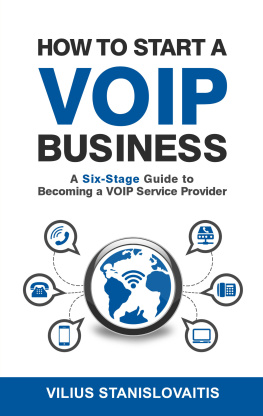
How to Start a VoIP Business
A Six Stage Guide to Becoming a VoIP Service Provider
Vilius Stanislovaitis
Smashwords Edition
How to Start a VoIP Business:
A Six-Stage Guide to Becoming a VoIP Service Provider
Vilius Stanislovaitis
Copyright 2016 by Vilius Stanislovaitis
All Rights Reserved
Copyeditor: Val Dumond and James Millington
Cover design: Ryan Lause
Diagrams design: Michael Cissell
Book Interior: Istvn Szab, Ifj.
All rights reserved. This book was self-published by the author Vilius Stanislovaitis. No part of this book may be reproduced in any form by any means without the express permission of the author. This includes reprints, excerpts, photocopying, recording, or any future means of reproducing text.
If you would like to do any of the above, please seek permission first by contacting me at http://www.runvoipbusiness.com
Published in Lithuania by Vilius Stanislovaitis
ISBN 978-609-408-828-5
Version 1.0
Table of Contents
The Story
Behind This Book
The story of this book began in 2009 at Kolmisoft, a company that specializes in providing billing and routing platforms to manage Voice over IP (VoIP) businesses. Some of the companys customers were existing VoIP service providers. Others were entrepreneurs who had launched their businesses based on VoIP technology for the first time.
Some of the startups wanted to launch a calling card business by offering cheap international calls to the ethnic community within their market. However, starting a business from scratch was frustrating for the entrepreneurs. They needed to work through a number of specific tasks, such as reviewing the telecommunications regulations in their market, performing a client and competitor analysis, establishing a company, finding reliable suppliers and partners, organizing sales and marketing, choosing the software and hardware solutions, and many more.
Going through all those procedures for the first time without any guidance made startups feel stressed rather than excited about the new business opportunity. Some of them gave up in the middle of the process because of limited time and energy. One of the main reasons for the early failures was that they couldnt find a trusted resource that would supply a step-by-step guide to starting and running a prepaid calling card service.
After a detailed market observation and analysis, the white paper How to Start Calling Card Business was released as a solution. The white paper enabled entrepreneurs to break a complex, overwhelming project into smaller manageable tasks, making it easy to start with the first one and to move on from there.
The demand for such a guide encouraged the development of the primary idea of that white paper into this informative yet simple book with practical examples, in order to explain the launching of different types of VoIP business.
Who Should
Read This Book
The book is written in very simple, non-technical language, making it easy for most readers to follow. There are four main groups of people whom the book serves. Youll most likely recognize yourself in at least one of them.
Startups and Entrepreneurs
These are people new to the telecom industry who are planning to launch a VoIP business in the near future. One of the key challenges for entrepreneurs is to create a realistic business plan and follow it. However, that is not so easy when you are starting a VoIP business from scratch. Putting different pieces together is a frustrating and time-consuming task. A more simple and convenient way is to develop a plan according to this guide, which is based on hundreds of real business cases. The book will be your virtual mentor and will lead you through the main stages of starting your own VoIP business step-by-step. Youll be able to learn from the success stories and mistakes of those people who have already gone through this process before you. Having a complete guide saves time and will keep you focused and productive.
Business Owners
There is no doubt that business owners and co-founders of VoIP companies will pick up this book excitedly. Not because they need a guide to start something new, but because this book is a story about them. All business owners were startups at some point and have gone through similar stages to those described here. This book reflects those ups and downs. Company founders familiar with this project were eager for this book, in order to give it as a gift to employees and clients, helping them to see the whole picture behind a VoIP business.
Technical People
The majority of these people are current or former employees of telecommunications companies with experience at the technical and operational level. One of the key problems for technical people is that they sometimes pay too much attention to the technology instead of focusing on the revenue-generating activities. In some cases, technicians spent a few years building a perfect VoIP platform that was ideally integrated with their website; and a majority of the processes where fully automated. The only issue was that they completely forgot whom they built it for; there were not enough customer attraction activities. As a result, most businesses such as these failed.
This book helps you to understand both the technical and commercial aspects of a VoIP business. You will learn what to focus on, which tasks to delegate or automate, and what to cross off your list.
Curious People
If you did not recognize yourself in any of the above profiles, but you are a curious person whod like to learn more about VoIP businesses, youll enjoy this book. The fact is that a lot of people are familiar with the VoIP concept, but only a few understand what is happening inside the VoIP providers environment.
This book offers solutions to something that is a mystery for many peoplehow to organize processes to generate revenue from VoIP services.
How to
Read This Book
A VoIP business is like a puzzle which consists of many small pieces that should be connected in the right way to get good results. Everyone can complete a puzzle; the only difference is: how fast? To make the complex simple, all of those pieces have been placed into six informative, easily-read chapters. The section titles are defined clearly so that they can be skipped by those who are already familiar with the material.
Chapter 1. Understanding Telephony
This is an introduction for those who are new to telephony. This part explains the evolution of the telecommunications industry and how it has changed over the decades. Youll also learn the benefits and value of VoIP and how it differs from traditional telephony.
Chapter 2. Choosing a VoIP Service
There are many services that can be provided by using VoIP technology. This part reviews the special aspects of various business models and services.
Chapter 3. Deciding on a Business Model
There are two VoIP business levels that you can choose from: reseller and service provider. This part will help you decide on the right business model according to your strengths. Besides this, you will learn how to define your target audience.
Chapter 4. Softswitch Selection
Softswitch is the key platform that connects calls between clients and providers. This part explains how to build a solid infrastructure and what components are needed to run different types of VoIP services. The content is not too technical; all terminologies are explained, so it is easily understandable.
Chapter 5. Finding Partners and Suppliers
To run a VoIP business, youll need to select multiple partners who will provide different resources for you. This chapter explains what type of partners and suppliers you need in a VoIP business.
Next page








